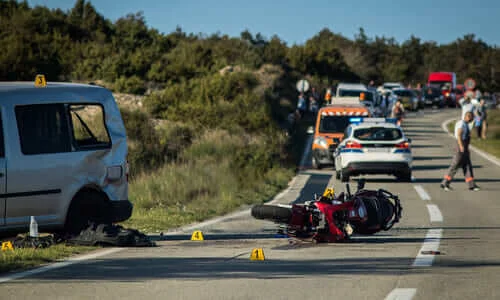Call 24/7 801-810-9999
Book a Consultation
Find out why so many clients appreciate the amount of work we put into their case.
"*" indicates required fields
 Unfortunately, motorcycle accidents cause a disproportional number of injuries for the motorcycle rider versus the passenger car’s occupants. Without safety features like seatbelts and airbags, bikers are vulnerable to a number of serious injuries, including:
Unfortunately, motorcycle accidents cause a disproportional number of injuries for the motorcycle rider versus the passenger car’s occupants. Without safety features like seatbelts and airbags, bikers are vulnerable to a number of serious injuries, including:
While there are many different kinds of motorcycle accidents, the one we see the most is the left-turn accident caused by a car or other vehicle turning in front of the motorcycle. Most of the time, the vehicle driver tells the responding officer that they didn’t see the motorcycle and they would never have pulled out if they did.
This is an unfortunate concern when riding a motorcycle – sometimes, other drivers won’t see you. There are some steps you can take to make yourself more visible, like wearing bright colors and using your headlamp, but even so, sometimes a motorist will miss you.
Drivers are encouraged to “Look twice and save a life,” but in case they don’t, it’s a good idea to be on the lookout for turning vehicles ahead.
Here are some tips to help keep you safe and reduce your risk of injuries when riding:
Research shows that helmet use reduces the risk and severity of head injuries and fatalities from motorcycle crashes. One study found that 51 percent of unhelmeted riders who suffered an injury required a stay in the ICU versus only 35 percent of helmeted riders.
Unhelmeted riders also had longer hospital stays, scored lower on the Glasgow Coma Scale (GCS), and were more likely to suffer poor outcomes.
Choose a helmet that fits snugly and doesn’t move when you shake your head. A full-face helmet gives you the most protection and also reduces the risk of eye and facial injuries, while a half-helmet leaves your face and eyes exposed.
Riding in long sleeves, pants, and sturdy boots offers the most protection if you are ejected from your bike during an accident.
Consider investing in a few pieces of riding gear, like a motorcycle jacket, pants, and gloves. These items are usually thick or padded to help absorb some of the impact when you contact the ground.
If you’re worried about the desert heat, you can buy ventilated outfits that help keep you cool while providing protection. A good pair of motorcycle gloves will protect your hands in a crash as well.
Many motorcyclists don’t think they need a defensive driving course. They may have been riding for years and feel they’re experienced in operating a motorcycle, and that might be true, but everyone can benefit from a defensive driving course for bikers.
These courses aren’t about covering the basics but teaching you how to react to vehicles and other possible hazards in the world around you. You could learn new tactics for avoiding collisions and reducing your risk of injury in an accident.
Always check your bike before riding, including your belts, brakes, fluids, and tire pressure. This can help head off problems that might derail your ride or cause you to crash, such as a blown tire.
Oil slicks, gravel, pieces of someone else’s blown tire, trash, or litter – these are everyday sightings on the road. For someone driving a car, most of these items are merely a mild inconvenience. But for a motorcyclist, they can cause a deadly accident.
With only two wheels, a bike can easily become destabilized if it skids or hits a piece of debris. At the same time, the driver of a car might barely notice if they ran over a board or other item on the road.
While it’s also essential to scan for other vehicles and hazards, try to glance at the road ahead of you frequently so you can spot and address any problems ahead of time.
For similar reasons, you should also pay attention to the weather forecast. Ice, snow, sleet, fog, and rain can have more severe consequences for bikers than vehicle drivers.
If you can avoid going out on your bike in bad weather, we recommend it. If not, remember to stay alert and reduce speed when precipitation begins or visibility drops.
It’s already more difficult for other drivers to see someone on a motorcycle, so try to help them out. Avoid spending any more time than necessary in another driver’s blind spot.
If you have to pass a larger vehicle, do it as fast as possible, and leave ample room when getting back over in front of the vehicle.
This is good advice for everyone, but especially motorcyclists. A car driver who rear-ends another vehicle may have no or minor injuries, but a biker could be seriously hurt from the impact.
At least four seconds of following distance is recommended.
If possible, move yourself and your bike out of the road. Check for injuries and call 911 to report the accident.
If you’re able to move around, find the vehicle driver and exchange contact and insurance info with them. When the police arrive, you should give honest answers to their questions, but don’t volunteer extra information or say any more than necessary.
Although many people brush off their injuries as minor, we recommend you let the paramedics check you over and see a doctor. Sometimes, pain and other symptoms don’t show up right away or are suppressed by the adrenaline rush of an accident, so seeking medical care can help ensure you don’t miss a potentially serious injury that requires treatment.
After getting medical care, please speak with a motorcycle accident attorney to protect your legal rights. The other driver’s insurance company may already be investigating the accident and looking for a way to blame you.
Your attorney will also investigate and work to ensure you receive all the damages you may be entitled to after your accident, including medical bills, lost income, pain and suffering, and more.
If you or a loved one need assistance after a motorcycle accident, please contact Valley Law Accident and Injury Lawyers for a free consultation. We’ll review the police report from your accident and advise you on your options.
If we take your case, you won’t owe us anything until we win or settle it. Call us today at 801-810-9999.
Get in touch


2021 and 2022 Gold Winner for Top Law Firm by Salt City Best
Call 24/7 801-810-9999